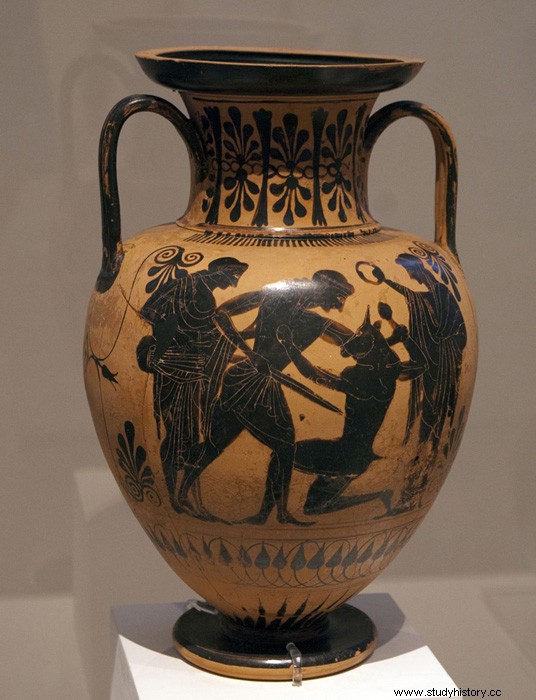
CIRCA 6000 BC
Birth of the Minoan civilization:
Peasants settle in Crete , an island in the Mediterranean Sea. Slowly their way of life leads to the first great civilization in Europe. The Minoans owe their name to King Minos who is believed to have reigned over the island.
The legend of King Minos:
According to a Greek legend, the god Zeus fell in love with a beautiful princess named Europa. He transformed into a bull and swam to Crete with the princess on his back. She gave birth to Minos, the first king of Crete.
CIRCA 2500 BC
Small villages grow and become towns.

CIRCA 1,900 BC
Construction of the first palaces:
Each city is built around a huge palace. That of Knossos is one of the biggest. It has over 1,000 rooms connected by hallways, stairways and courtyards. The walls of the palaces are decorated with colorful frescoes that depict scenes from palace life, plants and animals. The king presides over the ceremonies in the throne room. That of Knossos, in stone, is the oldest in Europe . It is still in its original place. The Minoans do not build large temples, but pray and make offerings to their gods in the halls of the palace set aside for this purpose, or in small outdoor mausoleums.
The legend of the Minotaur:
According to legend, the Minotaur was a half-man, half-bull creature who lived in a huge labyrinth beneath the palace of Knossos. Theseus, a young Greek prince, wanted to kill him, and Ariadne, the daughter of King Minos, gave him a magic sword and a spool of thread. Entering the maze, Theseus unrolled the thread behind him and with his sword, he killed the monster and had only to follow Ariadne's thread to get out.
Daily life in Crete:
Most Minoans are peasants who raise animals, cultivate and fish. Others trade locally or travel with their ships to trade or sell goods. The Minoans love bullfighting games such as bull aerobatics. The latter being venerated as the god of the sea, aerobatics was undoubtedly part of religious ceremonies.
Taxes:
As in Sumer, Egypt and the Indus Valley, peasants must give part of their crops and their productions to the palace. These foodstuffs are kept in reserves and are used to feed the dignitaries of the court and to pay the craftsmen of the palace. The rest is sold.
Write:
As soon as the Minoans begin to store foodstuffs and to trade, it becomes necessary for them to record the transactions. They use pictograms to begin with, then invent around 1650 BC. JC a form of writing called “linear A” that no one has ever been able to decipher.

CIRCA 1700 BC
Destruction of Minoan cities:
We do not know exactly what happened, but at that time, a volcano of Thera , a nearby island, erupted , possibly causing an earthquake or tidal wave.
CIRCA 1700 – 1450 BC
Crete is at its peak:
Cities and palaces are rebuilt.
CIRCA 1450 BC
Crete is invaded by the Mycenaeans (a people from Greece):
The Mycenaeans destroy the palaces and the Minoan civilization gradually fades.
